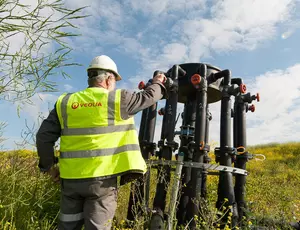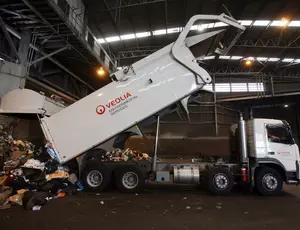Community Updates
Hallam Road Landfill’s community updates aim to help share an understanding of the operation by hosting informative resources and sharing planned and recent activities whilst providing a platform for Veolia and the local community to engage.
How The Site Operates
This timelapse captures and explains the key engineering stages for the creation of Cell 15 at the Hallam Road Landfill.
Key Site Updates
Cell 15 Creation
What work is being done?
Early in 2024, following the receival of EPA approvals, the Hallam Road Landfill will commence works to create and prepare the final landfill cells, Cell 15A and 15B. Cell 15 has been split into two segments 15A and 15B to reduce the time required between filled cells and intermediate capping.
The 15A cell construction requires the removal of two leachate ponds, treatment capacity has been planned for at the site's already established Leachate Treatment Facility. The volume of earth that will be moved to establish the cell is equivalent to 100 Olympic sized swimming pools (250,000㎥). An additional 7.6 Olympic sized swimming pools worth (19,000㎥) of specialised clay will be imported as a part of the lining process. Synthetic lining materials that will be applied can span the grounds of the MCG, fence to fence 1.8 times (36,000㎡).
These Cell 15A works will be undertaken from early 2024 and will be completed in early 2025. Third party auditing and EPA accreditation is required to ensure each stage of the landfill is created in accordance with the Best Practice Environmental Management guidance provided by the EPA.
The filling of the remaining cells will be coordinated with the final contour plan to ensure that it has a consistent topography.
Works update:
Cell 15, the second last landfill cell at the Hallam Road Landfill has been finalised. Third party auditing has been undertaken and EPA accreditation has been acquired to ensure each stage of the landfill has been completed in accordance with the Best Practice Environmental Management guidance provided by the EPA.
What's next:
The approval lead time allows for a comfortable transition between the current Cell 14B into the new Cell 15.
Over the coming months, Cell 14B will undergo interim capping with the installation of a sacrificial liner, receive vertical landfill gas wells for further extraction and treatment of landfill gas, and work will commence on the final cap design.
Posted 5 February, 2024 - Updated 16 June, 2025
Cell 14B Interim Capping and Landfill Gas Wells
Through the remainder of July, the Hallam Road Landfill will be applying an interim plastic liner to Cell 14B. This liner is a protective barrier to keep rainwater from entering the cell and to contain landfill gas within the cell so it can be managed by the landfill gas network.
Commencing in August, the next stage in this process is to drill 25 vertical gas wells into the cell. These vertical wells will support the capture of landfill gas in addition to the existing horizontal wells that are present during the filling of the cell. These works will support the efficiency of landfill gas capture, however there may be some odours while the works are undertaken.
These works are applied as site management and environmental controls until a final capping plan can be applied. Final capping will undergo design consideration and Environment Protection Authority review for approval.
Posted July 2025
Cells 12 and 13 Final Capping
At the end of July, the EPA approved the final capping design for Cells 12 and 13. The tendering process for the delivery of this work is underway.
The works are expected to commence in Q4 of 2025 and will be conducted on the eastern boundary, visible from Narre Warren South. The works will be completed within operating hours.
Works include the use of heavy machinery to prepare the Cell 12 and 13 area, apply a heavy duty plastic lining membrane and the final clay and top soil layers. During optimum weather conditions the landfill cap will be grass seeded as a means to prevent erosion of soil and improve visual amenity.
The final cap will support the efficiency of the existing landfill gas infrastructure.
Posted July 2025 - Updated 30 July 2025
Operational News
Educational Resources and FAQs
Educational Resources
Looking to learn more about our processes?
The following educational resources highlight landfill management practices and recycling tips.
Fact Sheets
Operational Fact Sheet
Contour Amendment Fact Sheets
Why is the landfill located on Hallam Road and how is it licensed?
The site of the Hallam Road Landfill was historically a quarry. The largely pre-dug area received a landfill licence and commended landfilling in 1997. The landfill is licensed to accept solid inert waste, putrescible (municipal kerbside) waste and shredded tyres until 31 Dec, 2040.
As a part of this licence, Veolia remains responsible for the restoration of the land and environment during the aftercare period (estimated to be 30 years) from the licence end date, before the land is handed back to the City of Casey. The aftercare period is an estimate, as the aftercare will continue until an independent Environmental Auditor and the EPA are satisfied with the site's remediation.
What type of waste is accepted at the landfill?
The Hallam Road site provides responsible environmental management of waste that cannot yet be reused or recycled from households, businesses and industry.
Waste types accepted:
Solid Inert Waste: This waste category contains hard waste that has a negligible activity or effect on the environment. The waste may be either a municipal or industrial waste. It includes solid materials such as demolition waste that has been determined as not appropriate for recycling. This waste has a low organic content.
Putrescible Waste: This waste category is commonly referred to as household waste, or kerbside waste collected by Councils. It includes material that has a higher organic content that decomposes over time and generates landfill gas
Biosecurity Waste: Biosecurity waste is material that has been seized at import or relates to waste that arrives offshore (commercial airline waste or galley waste). This waste is managed through agreed processes determined by the Department of Agriculture, Water and Environment. This does not include biohazardous waste, which is not permitted for disposal at Hallam Road.
Shredded tyres: The site is licensed to accept tyres which have been shredded, but rarely does so. This is because most tyres are recycled and rarely disposed of in landfill.
What are landfill cells?
Engineered landfill cells are constructed to encapsulate waste, leachate and landfill gas within a contained system.
Landfill cells are constructed in accordance with the Environment Protection Authority’s Best Practice Environmental Management, which provides guidelines and legislative objectives. During the construction and capping stages, landfill cells are third party auditor verified and approved by the EPA before filling can commence.
What's the difference between the transfer station and the landfill?
The transfer station managed by Outlook Environmental is open to the public for waste and recycling disposal. Materials recovered from the transfer station are reused and recycled to prevent them going to landfill. To learn more about Outlook Environmental's social enterprise click here.
The landfill managed by Veolia accepts waste from commercial customers and is not open to the public.
What is landfill gas and how is it managed?
Landfill gas is generated within landfill cells as organic matter breaks down over time.
Landfill gas is managed by placing horizontal wells in the waste mass of the landfill cell during each strategic lift as waste is placed in the landfill cell. Once the cell reaches height additional vertical wells are drilled. The onsite gas capture system draws the landfill gas under vacuum and the combustible methane is converted to energy through the use of on-site engines. This process contributes enough electricity to the network to supply power to some 15,000 homes per year. Additional flares are used to neutralise landfill gas and support the engines during required maintenance periods.
For further understanding of landfill gas at Hallam Road landfill please explore these EPA resources, demonstrating periodic studies of the Hallam Road Landfill.
What is leachate and how is it managed?
Leachate is liquid generated from the waste mass within the landfill cell, or any liquid that comes in contact with the waste mass.
The design of each landfill cell allows for leachate to be captured and pumped by the leachate sump to the onsite leachate treatment facility.
The leachate treatment facility allows for onsite treatment of the liquid. Treatment includes aeration, which provides an oxygen rich environment for microorganisms to break down ammonia within the liquid. Additional treatments can be applied to restore pH and ammonia balances from time to time.
Following treatment, the liquid meets the environmental standards of the water authority trade waste agreement. An approval is issued by the water authority to discharge liquid to the sewer for further treatment. Each discharge of leachate to the sewer requires a new approval to be issued by the water authority.
What measures are undertaken to control dust, sediment and litter?
There are several controls in place to manage dust, sediment and litter including;
- Application of interim cover to contain waste at the tip-face
- Placement of litter nets to stop litter from leaving the active cell
- Sealed roads and mandatory use of a wheel wash for trucks exciting the site during wet conditions
- Ongoing use of a street sweeper to maintain roads and capture debris
- Use of an on-site water cart to apply preventative dust suppression
- Planned closure of site if forecasts exceed the wind threshold for current operations
- Regular environmental monitoring to ensure compliance, including audits conducted by an Environmental Auditor
Additionally, it is important to note that Hallam Road Landfill is not licensed to accept contaminated soil.
What happens after the landfill closes?
After the landfill is closed Veolia will remediate and maintain the site during the aftercare period (which is estimated to be 30 years). The land will be returned to the council after remediation has been achieved and it has been approved as compliant by an independent auditor and EPA.
Waste will continue to decompose and create gas within the landfill cells even after the landfill is closed, although this will reduce in volume over time.
During the aftercare period Veolia will be responsible for:
-
Capping the final landfill cell and remediation of landscape
-
Ongoing environmental monitoring of landfill gas, leachate, groundwater and stormwater
-
Ongoing maintenance of the site including landscaping and the landfill infrastructure that manages leachate and the landfill gas network
-
Ongoing engagement of a landfill gas management contractor who converts landfill gas into electricity.
You can learn more about the management of closed landfills via the EPA’s resources here
Hallam Road Landfill Community Reference Group (CRG)
The Group provides a forum for discussion and feedback between the Veolia project team and representatives of the community and local councils on matters relating to the Veolia Hampton Park facility. This facilitates community awareness of the operations, environmental performance and any development of the facility, and fosters understanding and cooperation to minimise the impact of the facility on the local community. The CRG is not a decision-making body; it performs an advisory and consultative role.
If you are interested in knowing more, please contact Currie for a copy of the Terms of Reference and nomination form:
- Email [email protected]
- Call 0439 389 202
Hallam Road Landfill CRG meeting minutes
2025
2025 February: Hampton Park CRG Meeting Minutes
2025 May: Hampton Park CRG Meeting Minutes
2024
2024 March: Hampton Park CRG Meeting Minutes
2024 June: Hampton Park CRG Meeting Minutes
2024 September: Hallam Road CRG Meeting Minutes
2024 December: Hampton Park & Taylors Road Meeting Minutes
2023
2023 March: Hampton Park CRG Meeting Minutes
2023 June: Hampton Park CRG Meeting Minutes
2023 September: Hamtpon Park CRG Meeting Minutes
2023 December: Hampton Park & Taylors Road Meeting Minutes
2022
2022 February: Hampton Park CRG Meeting Minutes
2022 April: Hampton Park CRG Meeting Minutes
2022 June: Hampton Park CRG Meeting Minutes
2022 September: Hampton Park CRG Meeting Minutes
2022 December: Hampton Park & Taylors Road CRG Meeting Minutes
CONTACT US
If you would like to get in touch with the engagement team, or provide feedback about key site updates please email [email protected] or call our 24/7 contact centre on 1800 368 737 and our team will get back to you





